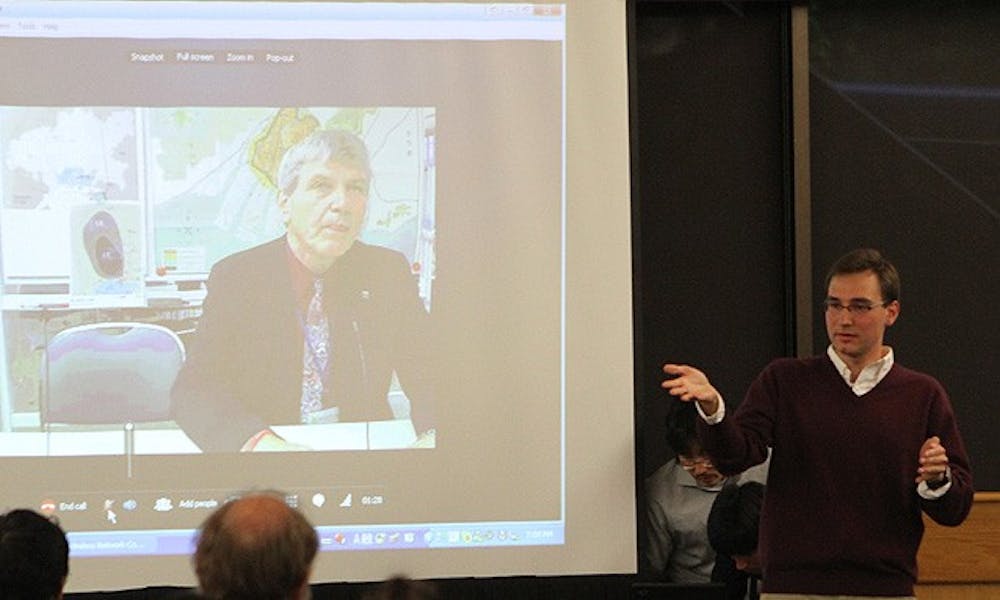Duke students had the rare opportunity Friday to learn about the present nuclear situation in Japan as well as Japan’s nuclear history from a primary source: a survivor of the 1945 Hiroshima bombing.
The presentation, titled “Exploring Japan’s Nuclear Past and Future: Surviving the Atomic Bomb,” was sponsored by the Duke East Asia Nexus. The event was held in the Von Canon rooms and featured Hiroshima survivor Koji Hosokawa, among other professors and speakers, who discussed the infamous nuclear attack and Japan’s current nuclear situation as well as the dangers of nuclear technology.
Simon Partner, an associate professor of history, opened the event with a short talk to provide historical context for the rest of the program. Partner discussed Japan’s history and relationship with the United States and questioned Japan’s ability to improve nuclear safety in the future. David Richardson, an associate professor of epidemiology at the University of North Carolina at Chapel Hill, also spoke at the event about the effects of radiation in both Hiroshima and Fukushima, home of the damaged nuclear reactor currently leaking radiation.
Hosokawa joined the discussion from Hiroshima via Skype along with Steven Leeper, chairman of the Hiroshima Peace Culture Foundation, an organization founded by the Hiroshima city government to promote peace initiatives and educate others. Hosokawa communicated with the help of a translator.
The 83-year-old survivor said that at the time of the bombing, he was about 1.3 kilometers from its hypocenter, but his younger sister was only 700 meters away. Hosokawa, then 17 years old, survived the bombing because he was working inside a large concrete building installing communication lines to prepare for an expected U.S. invasion. His sister, however, was working outside with schoolmates.
“I had just got started working on the fourth floor, when I suddenly saw that blinding flash of light, and I was thrown off my feet and crashed into the wall,” he said. “I temporarily lost my hearing so I didn’t even hear the explosion, and I was cut by fragments of the window pane that came flying towards me and suffered quite a shock from the blow of being thrown.”
Hosokawa said his sister crawled to safety across a railroad bridge and was picked up by military patrol. The nurse who treated her at the hospital later wrote a letter to the Hosokawa family informing them of what had transpired.
The event also featured multimedia from Hosokawa’s young adulthood, including photographs of his sister juxtaposed alongside images of her school uniform burned and torn by the bomb and other pictures of her school in ruins.
In an attempt to forget what had happened, Hosokawa said he refused to speak out about his experiences until 2000. It was at this time he decided the education of others was more important.
“The thing is the average age of us survivors is over 78—we know that we’re not going to be here much longer and we feel a responsibility to universalize our experiences and hand them down,” he said. “I feel like I was given life in order to tell these stories and convey this message, and this is why I started talking.”
Leeper and Hosokawa spoke as part of HPCF’s A-bomb exhibitions program. The project began in 2007 with 101 exhibitions in the United States and aims to raise awareness about nuclear issues. The exhibitions later transitioned to video conferences, which decreased cost, allowing for greater exposure and decreasing the stress on survivors.
“We are not trying to get an apology or reparations or any of those kinds of things. We are absolutely not trying to talk about if [the bombing] was just justified or not justified,” Leeper said. “We are only doing this as a warning about the future, to say that this problem is not solved. It could jump from our past into our present at any minute, and we need to do something about it, and we need to take action now.”
The event also featured a short anime film called “Pica Don” that depicted the bombing and a discussion led by artist Elin O’Hara Slavick, distinguished term professor of art at UNC.
DEAN President Paul Horak, a sophomore, said he was excited about the program and its turnout.
“It was proof that there are people in the Duke community who care about nuclear weapons and the future of nuclear energy,” Horak said.
Attendee Sharif Labban a freshman, said he was impressed by the opportunity to interact with a survivor of such a monumental historical event.
“It’s so easy to become desensitized to things like that,” Labban said. “I felt like this was a rare opportunity to understand what happened in a more truthful way.”
Get The Chronicle straight to your inbox
Signup for our weekly newsletter. Cancel at any time.

